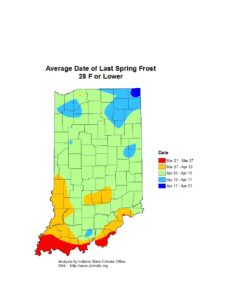The old adage says that March comes in like a lion and out like a lamb. The first few days of March started off quite normal and then quickly transitioned to lamb-like (not an official meteorological term) conditions. Then the roller coaster ride began with above-normal temperatures, followed by cooler, stormier conditions, followed by milder temperatures.
Typical Indiana.
Will March end on a calmer, warmer note? According to the national Climate Prediction Center, temperatures from March 29th through April 2nd should be near normal with slight chances of above-normal temperatures in the northern part of Indiana. Precipitation is favored to be above normal during this time. Of course, there’s another adage that says April showers bring May flowers, so hopefully this increased chance for rain will be just enough to moisten without flooding the area.
La Niña is still ongoing in the tropical Pacific Ocean, though models are predicting that it should weaken to more neutral conditions later this spring and early summer. While the sample size for past La Niña springs is low, the average pattern has been warmer-than-normal and wetter-than-normal conditions. Climate outlooks seem to be picking up on this pattern and predicting the same for this year.
Perennials are starting to wake up after their winter dormancy. Chilling hours – based on temperatures between 35°F and 45°F – have accumulated between 900-1000 units in the northern part of the state to over 1200 units in southern counties along the Ohio River (Figure 1). This is near- to slightly-above normal for this time of year. Hopefully, this will translate to abundant yields for fruit growers!
Based on climatology, the average date of the last hard freeze (28°F or colder) has occurred sometime between April 3rd and April 10th (Figure 2). The climate outlooks for early April indicate enhanced probabilities for above normal temperatures. Barring any unusual polar air mass quickly moving into the region, the risk for one more hard-freeze event should be very low for the rest of this spring season.

